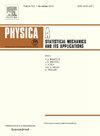Traffic network: A cascade fault-oriented flow allocation method
IF 2.8
3区 物理与天体物理
Q2 PHYSICS, MULTIDISCIPLINARY
Physica A: Statistical Mechanics and its Applications
Pub Date : 2025-01-27
DOI:10.1016/j.physa.2025.130394
引用次数: 0
Abstract
In the field of complex networks, cascade failure has been widely studied due to its ubiquity and profound impact. The urban rail transit network is designed such that failures at one station or part would propagate throughout the network, affecting train operations at nearby stations or sections as well as disrupting passenger flow throughout the network. A sensible passenger flow assignment plan can enhance a network operation's emergency reaction capability and significantly lessen the impact of a network cascade failure in the event of a failure. However, current passenger assignment models aimed at reducing the phenomenon of cascading failures are not comprehensive and do not fully consider the impact of the overall network centrality and path flow capacity on network cascading failures. This study defines the term "path flow capacity" and proposes a traffic network pass-passenger assignment model (New_CC) with Tsallis entropy, based on the concept of system load balancing. The model gives weight to the connecting edges of the traffic network, integrates the betweenness centrality with the theory of structural holes, and enhances the initial passenger flow assignment technique. The distribution results can improve the path flow capacity of the network to a certain extent, and the overall distribution of liquidity is relatively average. Then we define a new cascading failure model, this model is used to determine the path flow capacity at various nodes and investigate the traffic network's resistance to cascading failure under various load distribution methods, using the path flow capacity at nodes as the initial load. The findings indicate that compared to the traditional model, the New_CC model makes more sense. There is almost no overloading between neighboring nodes, and some of the central node traffic is dispersed to the outer nodes of the network. There is no phenomenon that the loads of consecutive nodes on a road are too large at the same time, which causes the transportation network to be blocked at multiple nodes at the same time. In addition, the improved passenger flow assignment model can enhance the path flow capacity of the network to a certain extent, and all the effective paths take up as much as possible the passenger flow between the OD pairs corresponding to the paths in the network.The traffic network's cascade fault model is more robust and can withstand intentional attacks at a lower cost when used in a cascade fault simulation where the path flow capacity serves as the initial load. The improvement of robustness will be further strengthened with the increase of the propagation rate threshold and the decrease of the average degree. From a transportation network perspective, protecting nodes with greater path flow capacity is also a better way to prevent cascading failures, reduce maintenance costs, and give decision makers more options.
求助全文
约1分钟内获得全文
求助全文
来源期刊
CiteScore
7.20
自引率
9.10%
发文量
852
审稿时长
6.6 months
期刊介绍:
Physica A: Statistical Mechanics and its Applications
Recognized by the European Physical Society
Physica A publishes research in the field of statistical mechanics and its applications.
Statistical mechanics sets out to explain the behaviour of macroscopic systems by studying the statistical properties of their microscopic constituents.
Applications of the techniques of statistical mechanics are widespread, and include: applications to physical systems such as solids, liquids and gases; applications to chemical and biological systems (colloids, interfaces, complex fluids, polymers and biopolymers, cell physics); and other interdisciplinary applications to for instance biological, economical and sociological systems.

 求助内容:
求助内容: 应助结果提醒方式:
应助结果提醒方式:


